Higher education student enrolments and qualifications obtained at higher education institutions in the United Kingdom for the academic year 2010/11
Introduction
This Statistical First Release (SFR) has been produced by the Higher Education Statistics Agency (HESA) in collaboration with statisticians from the UK Department for Business, Innovation and Skills (BIS), the Welsh Government (WG), the Scottish Government (SG) and the Department for Employment and Learning Northern Ireland (DEL(NI)). It has been released according to the arrangements approved by the UK Statistics Authority. It provides details of student enrolments and qualifications obtained by higher education (HE) students at HE institutions (HEIs) in the United Kingdom (UK) for the academic year 2010/11. This SFR also includes information from the HESA Aggregate Offshore Record. This record captures students studying wholly outside the UK who are either registered with the reporting institution or who are studying for an award of the reporting institution.
Readers should be aware that data definitions sometimes change over time and this can affect the validity of time series comparisons. Any significant changes have been explained in the Notes to Editors and/or Definitions.
Please note, key points have been derived from the Excel tables (these can be found below). Comparisons with previous year's data have only been included where they can be derived from these tables.
Key points - enrolments (all UK HEIs)
The total number of HE enrolments at UK HEIs stood at 2,501,295 in 2010/11, showing no percentage increase from 2009/10. Postgraduate enrolments increased by 2% between 2009/10 and 2010/11 while undergraduate enrolments showed a slight decrease between 2009/10 and 2010/11 (see Table 1 and Chart 1).
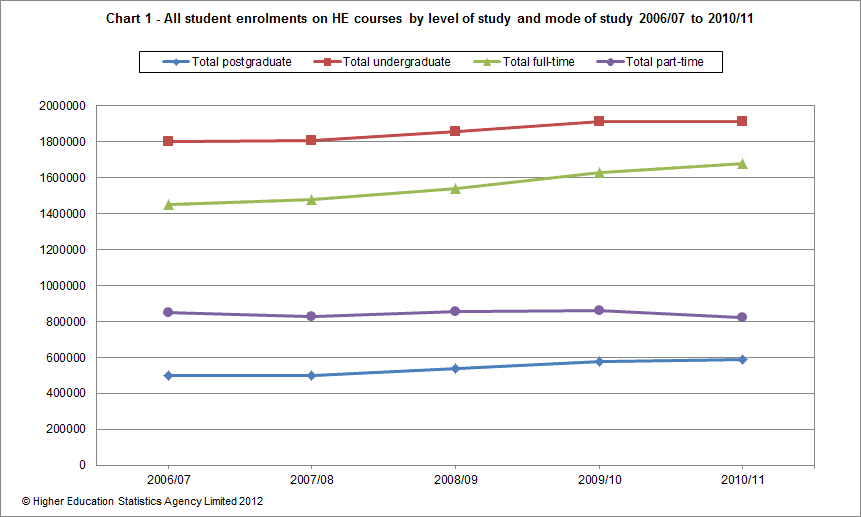
Over the time series shown in this SFR the overall numbers enrolled on HE courses has steadily increased from 2,304,705 in 2006/07 to 2,501,295 in 2010/11. Postgraduate numbers saw a slight decrease between 2006/07 and 2007/08 but have increased each year since. Undergraduate enrolments have increased each year over this same time frame with a slight decrease in 2010/11.
1,677,345 of all enrolments were full-time, an increase in numbers of 3% since 2009/10, continuing the trend of increasing full-time numbers over the time series shown. 823,955 enrolments were part-time showing a decrease of 4% since 2009/10. Part-time numbers have seen slight decreases in 2007/08 and 2010/11 (Ref. Table 1 and Chart 1).
Similar trends were observed in the numbers of first year enrolments on HE courses between 2006/07 and 2010/11, with only postgraduate numbers observing an increase in first year enrolments in 2010/11 (Ref. Table 2 and Chart 2).
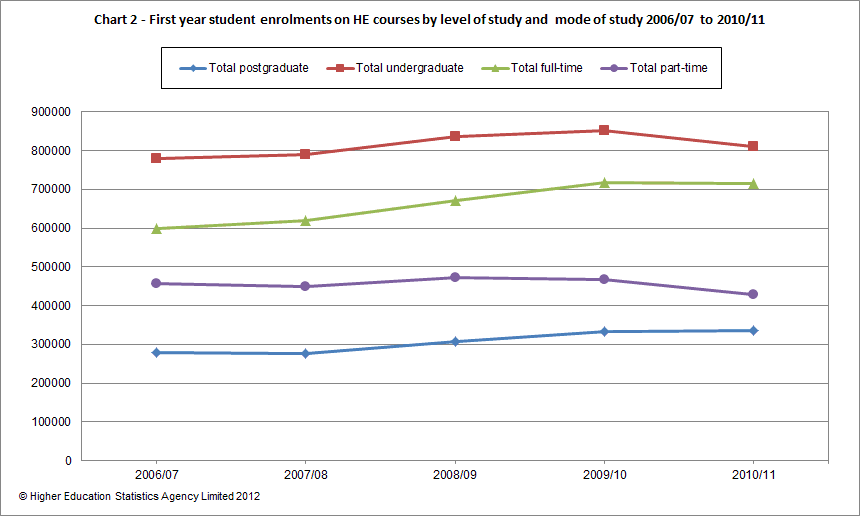
The total number of first year enrolments stood at 1,145,970 in 2010/11 a decrease of 3% since 2009/10. The number of full-time first year enrolments showed no percentage change between 2009/10 and 2010/11, while part-time first year enrolments decreased by 8% over the same period. The number of postgraduate first year enrolments increased by 1% and undergraduate first year enrolments decreased by 5%. (Ref. Table 2 and Chart 2).
In 2010/11 UK domiciled students accounted for 83% of all enrolments at UK HEIs, 5% were EU domiciled and the remaining 12% came from countries outside the EU. The number of student enrolments from outside the EU increased by 6% from 2009/10 (from 280,760 to 298,110). The number of all other European Union (EU) domiciled students increased by 4% (from 125,045 to 130,120). Over the same period, the number of UK domiciled students decreased by 1% (from 2,087,615 to 2,073,070). (Ref. Table 1).
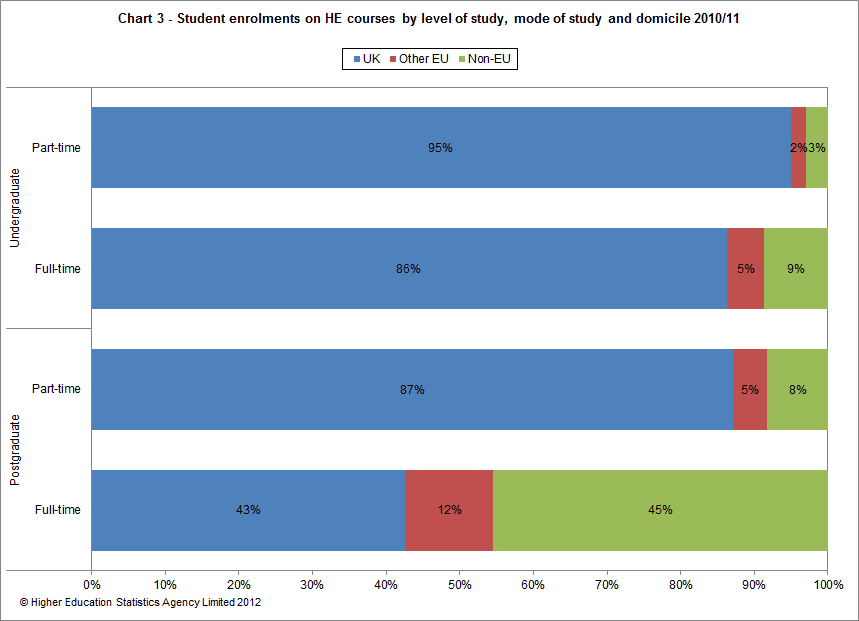
Proportions of students from outside the UK varied by both level and mode of study in 2010/11. 45% of full-time postgraduates were Non-EU domiciled and 95% of part-time undergraduates were UK domiciled (Ref. Chart 3).
Proportions of students from outside the UK also varied across the four administrations. Institutions in Wales had the greatest proportion of non-EU domiciled students at 15%, while institutions in Northern Ireland had the greatest proportion of Other EU domiciled students at 9% (Ref. Chart and Table 1a).
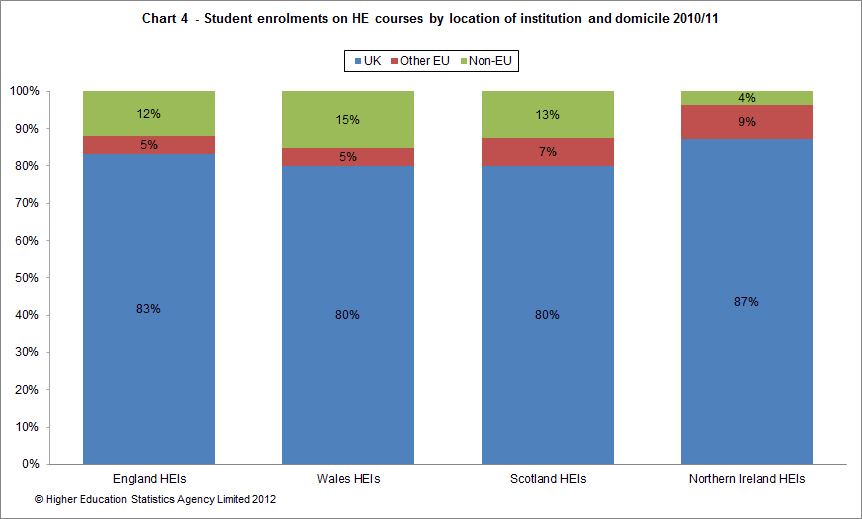
44% of full-time enrolments in 2010/11 were in science subjects, showing no percentage change between 2009/10 and 2010/11. 36% of part-time enrolments in 2010/11 were in science subjects, also showing no percentage change between 2009/10 and 2010/11. (Ref. Table 3)
The greatest percentage increase in postgraduate student enrolments between 2009/10 and 2010/11 was observed in Mathematical sciences (8%). The largest percentage decrease in postgraduate numbers was observed in Computer science (6%). For undergraduate enrolments the greatest percentage increase was observed in Agriculture and related subjects while undergraduate enrolments in Architecture, building and planning decreased by (6%) (Ref. Table 3 and Chart 5)
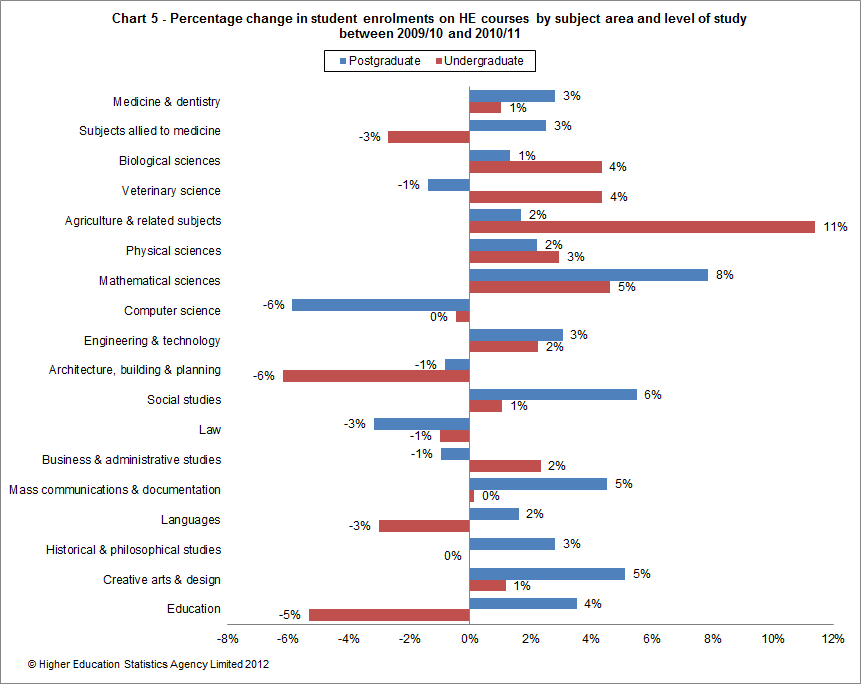
Chart 6 shows the cross border flows of UK domiciled first year enrolments by the country of domicile and country of institution (excluding those studying at the Open University, refer to note 5 for further clarification). Across all regions the majority of students stay in their home country. 24% of first year students from Wales were enrolled at HEIs in England. 5% of first year students from Northern Ireland were enrolled at HEIs in Scotland.
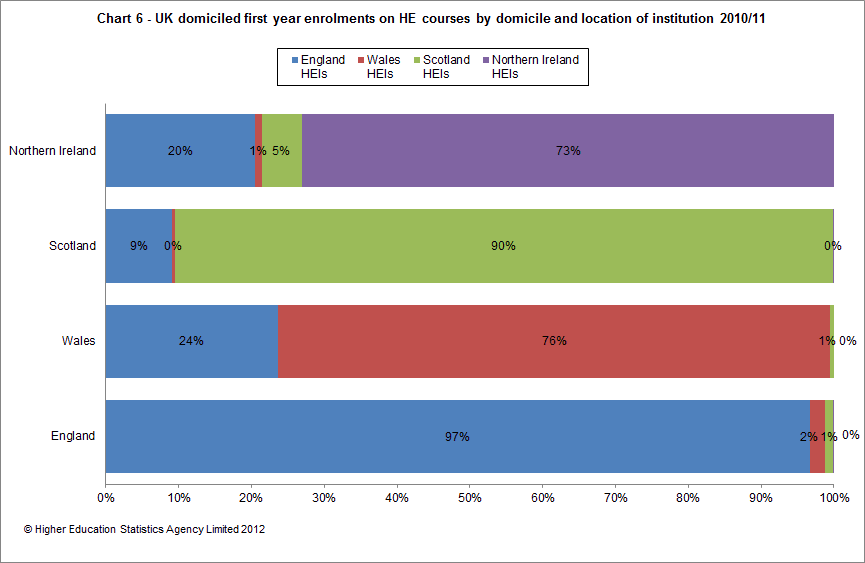
Key points - qualifications obtained (all UK HEIs)
In 2010/11, there were 762,540 HE qualifications obtained in the UK compared to 716,940 in 2009/10, showing an increase of 6%. Of these 369,010 were at first degree level, compared to 350,860 in 2009/10, showing an increase of 5%. (Ref. Table 5)
First degree qualifications accounted for 48% of all HE qualifications obtained in 2010/11 and other undergraduate qualifications (including foundation degrees and excluding undergraduate PGCE) accounted for 18%. (Ref. Table 5 and Chart 7)
Postgraduate qualifications (excluding postgraduate PGCE) accounted for 30% and PGCE qualifications (at postgraduate and undergraduate level) accounted for the remaining 4%. (Ref. Table 5 and Chart 7)
Chart 7 illustrates the distribution of qualifications obtained in 2010/11.
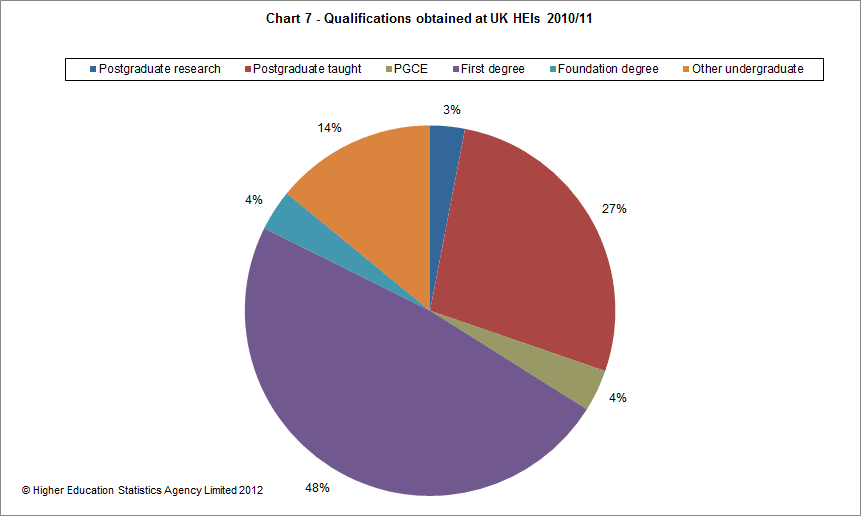
Over the time series shown in this SFR, all qualifications have shown an overall increase in numbers between 2006/07 and 2010/11 except for other undergraduate which peaked in 2007/08 and then fell in 2008/09-2010/11. (Ref. Table 5 and Chart 8)
Foundation degrees have shown the largest proportional increase over the 5 year time period and overtook the number of postgraduate research qualifications in 2009/10. (Ref. Table 5 and Chart 8)
Chart 8 shows the time series trend in qualifications obtained between 2006/07 and 2010/11 by level of qualification obtained.
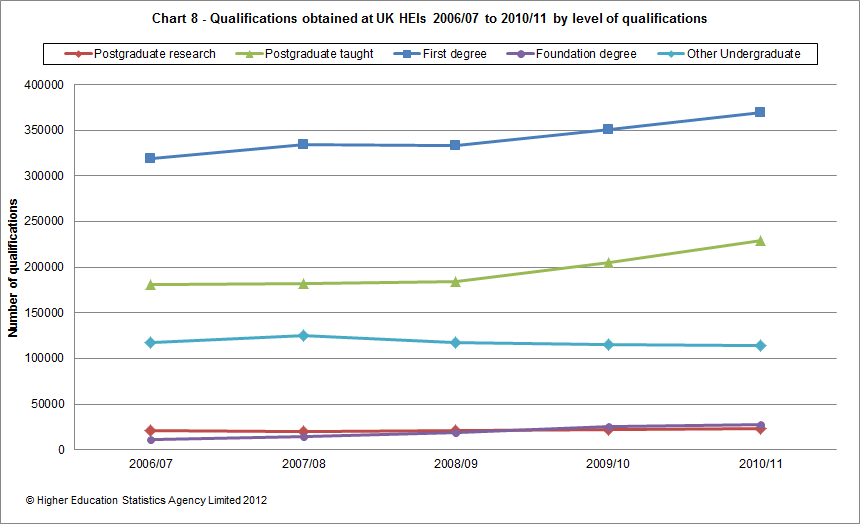
Of those gaining a classified first degree, the proportion who obtained a first or upper second has shown a steady increase from 60% in 2006/07 to 64% in 2010/11. (Ref. Table 6)
Chart 9 shows the percentage distribution of first degree classifications by mode and gender in 2010/11
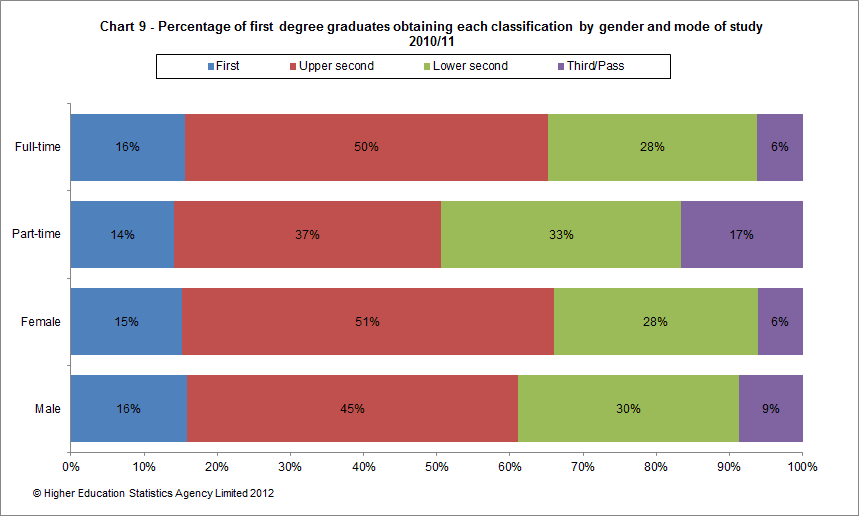
65% of first degrees undertaken through full-time study in 2010/11 achieved First or Upper second classifications compared to 51% of those undertaken through part-time study. (Ref Table 6 and Chart 9)
66% of first degree classifications achieved by females in 2010/11 were at First or Upper second level compared to 61% of those achieved by males. (Ref Table 6 and Chart 9)
57% of first degree graduates in 2010/11 were women, which has remained constant over the 5 year time series. (Ref. Table 5)
In 2010/11, 39% of qualifications obtained were in science subjects, a decrease in the proportion since 2006/07 despite an overall increase in numbers. In 2006/07, 37% of qualifications achieved by women were in science subjects compared to 45% for men. These showed a small change over the 5 year time series to 35% and 45% respectively in 2010/11 (Ref. Table 7)
Key points - students studying wholly overseas (all UK HEIs)
In 2010/11, there were 503,795 students studying wholly overseas compared to 408,685 in 2009/10. (Ref. Table 8)
Of those students studying wholly overseas in 2010/11, 14% were studying within the EU compared to 17% in 2009/10. (Ref. Table 8)
Chart 10 shows the number of students who were studying wholly overseas between 2008/09 to 2010/11 by level of provision and location of study.
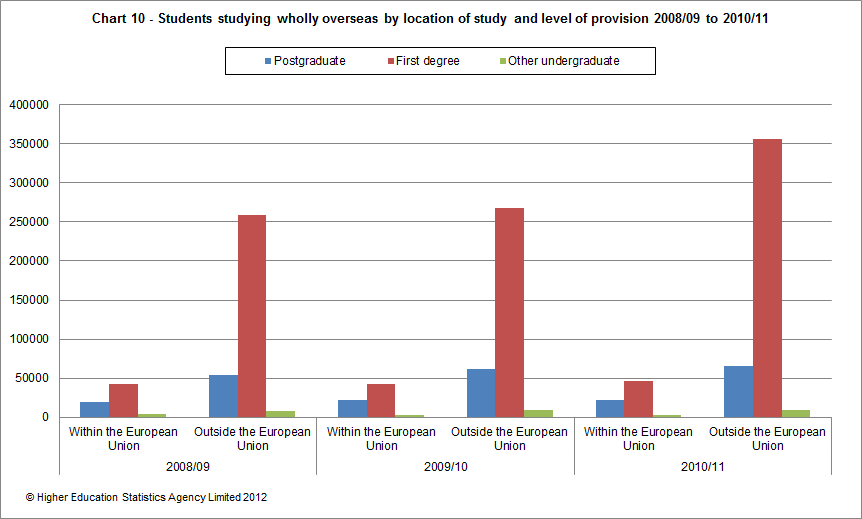
Key points - enrolments (England only)
The total number of HE enrolments at English HEIs stood at 2,097,215 in 2010/11, showing no percentage change from 2009/10. Postgraduate enrolments increased by 1% and undergraduate enrolments showed no percentage change between 2009/10 and 2010/11. (Ref. Table 1a)
Between 2009/10 and 2010/11, the number of enrolments of UK domiciled students decreased by 1% (from 1,758,680 to 1,746,065). The number of all other European Union (EU) domiciled students increased by 5% (from 98,060 to 102,700). Over the same period, the number of Non-EU domiciled students increased by 5% (from 236,900 to 248,455). (Ref. Table 1a)
The number of full-time first year enrolments increased by 1% between 2009/10 and 2010/11, part-time first year enrolments decreased by 9% over the same period. The number of postgraduate first year enrolments increased by 1% and undergraduate first year enrolments decreased by 5%. (Ref. Table 2a and Chart 11)
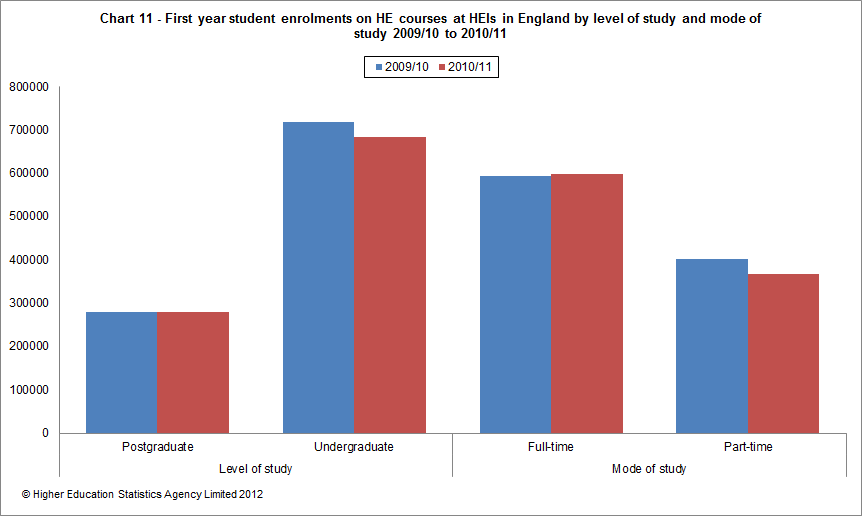
In 2010/11, 97% of English domiciled first year undergraduates studied at English HEIs (excluding The Open University), the same as in 2009/10. Similarly, 96% of English domiciled first year postgraduates studied at English HEIs (excluding The Open University), the same as in the previous year. (Ref. Table 4 & Chart 6)
Key points - qualifications obtained (England only)
In 2010/11 there were 308,340 first degree graduates compared to 292,410 in 2009/10, an increase of 5%. (Ref. Table 5a)
First degrees accounted for 48% of qualifications obtained in 2010/11. (Ref. Table 5a and Chart 12)
Chart 12 illustrates the distribution of qualifications obtained at England HEIs in 2010/11.
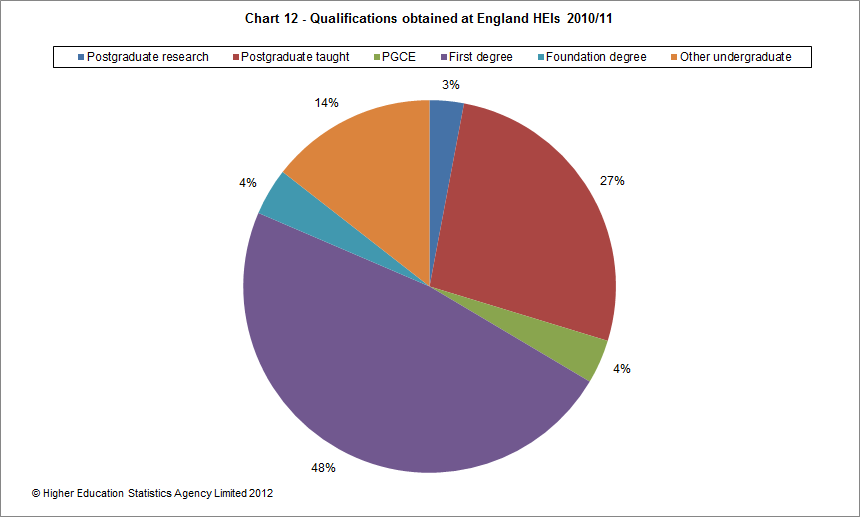
56% of first degree graduates in 2010/11 were women, the same proportion as in 2009/10. (Ref. Table 5a)
209,465 HE qualifications obtained in 2010/11 were at Postgraduate level, an increase of 11% from 2009/10. (Ref. Table 5a)
Key points - enrolments (Wales only)
The total number of HE enrolments at Welsh HEIs stood at 131,005 in 2010/11, an increase of 2% from 2009/10. Postgraduate enrolments increased by 7% and undergraduate enrolments increased by 1% between 2009/10 and 2010/11. (Ref. Table 1a)
Between 2009/10 and 2010/11, the number of enrolments of UK domiciled students increased by 1% (from 103,855 to 104,715). The number of all other European Union (EU) domiciled students decreased by 6% (from 6,845 to 6,455). Over the same period, the number of Non-EU domiciled students increased by 15% (from 17,185 to 19,835). (Ref. Table 1a)
The number of full-time first year enrolments increased by 1% between 2009/10 and 2010/11. Part-time first year enrolments showed no percentage change over the same period. The number of postgraduate first year enrolments increased by 8% and undergraduate first year enrolments fell by 2%. (Ref. Table 2a and Chart 13).
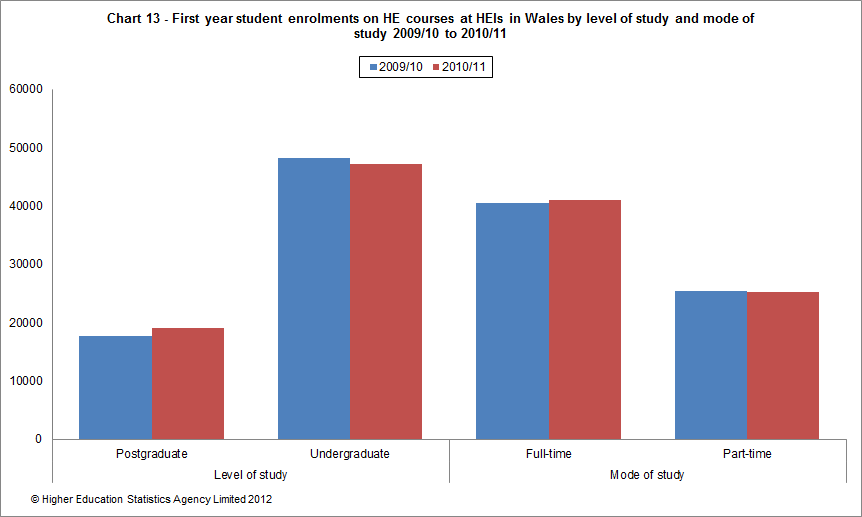
In 2010/11, 77% of Welsh domiciled first year undergraduates studied at Welsh HEIs (excluding The Open University), compared to 79% in 2009/10. In 2010/11, 69% of Welsh domiciled first year postgraduates studied at Welsh HEIs (excluding The Open University), compared to 68% the previous year (Ref. Table 4 and Chart 6)
Key points - qualifications obtained (Wales only)
In 2010/11 there were 20,780 first degree graduates compared to 19,215 in 2009/10, an increase of 8%. (Ref. Table 5a)
First degrees accounted for 50% of qualifications obtained in 2010/11. (Ref. Table 5a and Chart 14)
Chart 14 illustrates the distribution of qualifications obtained at HEIs in Wales in 2010/11.
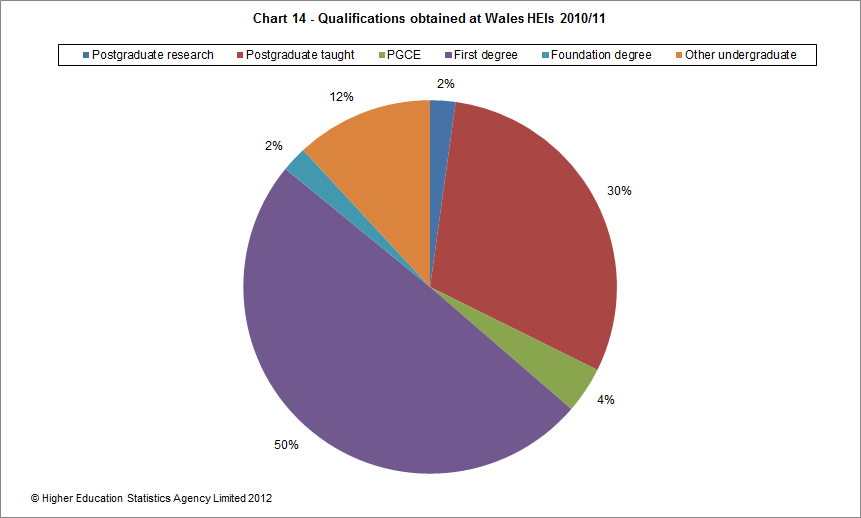
56% of first degree graduates in 2010/11 were women, compared to 57% in 2009/10. (Ref. Table 5a)
14,890 HE qualifications obtained in 2010/11 were at Postgraduate level, an increase of 14% from 2009/10. (Ref. Table 5a)
Key points - enrolments (Scotland only)
The total number of HE enrolments at Scottish HEIs stood at 221,075 in 2010/11, showing no percentage point change from 2009/10. Postgraduate enrolments increased by 3% and undergraduate enrolments decreased by 1% between 2009/10 and 2010/11. (Ref. Table 1a)
Between 2009/10 and 2010/11, the number of enrolments of UK domiciled students decreased by 2% (from 179,905 to 176,885). The number of all other European Union (EU) domiciled students increased by 2% (from 15,930 to 16,310). Over the same period, the number of Non-EU domiciled students increased by 11% (from 25,075 to 27,880). (Ref. Table 1a)
The number of full-time first year enrolments decreased by 6% between 2009/10 and 2010/11, part-time first year enrolments fell by 11% over the same period. The number of postgraduate first year enrolments decreased by 2% and undergraduate first year enrolments fell by 10%. (Ref. Table 2a and Chart 15)
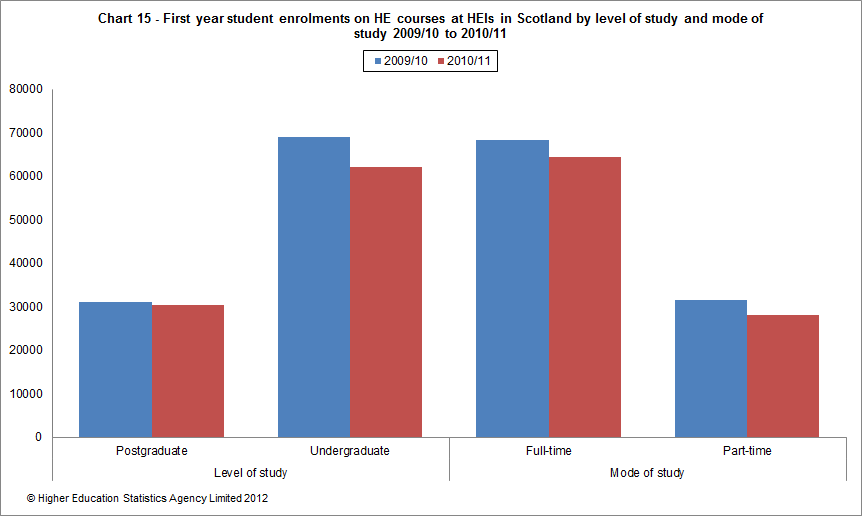
In 2010/11, 92% of Scottish domiciled first year undergraduates studied at Scottish HEIs (excluding The Open University), compared to 93% in 2009/10. Similarly, 85% of Scottish domiciled first year postgraduates studied at Scottish HEIs (excluding The Open University), compared to 86% in 2009/10. (Ref. Table 4 and Chart 7)
Key points - qualifications obtained (Scotland only)
In 2010/11 there were 31,780 first degree graduates compared to 30,995 in 2009/10, an increase of 3%. (Ref. Table 5a)
First degrees accounted for 51% of qualifications obtained in 2010/11. (Ref. Table 5a and Chart 16)
Chart 16 illustrates the distribution of qualifications obtained at Scotland HEIs in 2010/11.
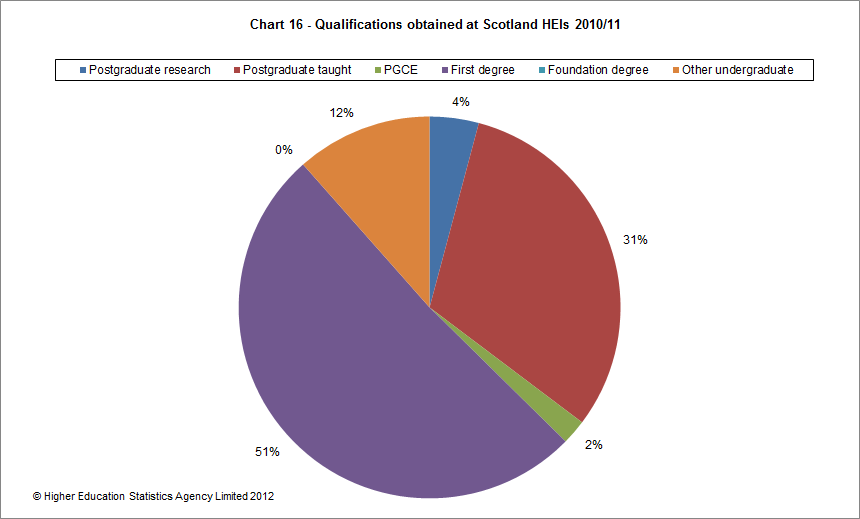
58% of first degree graduates in 2010/11 were women, the same proportion as in 2009/10. (Ref. Table 5a)
23,250 HE qualifications obtained in 2010/11 were at Postgraduate level, an increase of 10% from 2009/10. (Ref. Table 5a)
Key points - enrolments (Northern Ireland only)
The total number of HE enrolments at Northern Ireland HEIs stood at 52,000 in 2010/11, an increase of 2% from 2009/10. Postgraduate enrolments increased by 2% and undergraduate enrolments also increased by 2% between 2009/10 and 2010/11. (Ref. Table 1a)
Between 2009/10 and 2010/11, the number of enrolments of UK domiciled students increased by 1% (from 45,180 to 45,405). The number of all other European Union (EU) domiciled students increased by 11% (from 4,210 to 4,655). Over the same period, the number of Non-EU domiciled students increased by 21% (from 1,605 to 1,945). (Ref. Table 1a)
The number of full-time first year enrolments decreased by 7% between 2009/10 and 2010/11, part-time first year enrolments increased by 1% over the same period. The number of postgraduate first year enrolments decreased by 6% and undergraduate first year enrolments fell by 3%. (Ref. Table 2 and Chart 17)
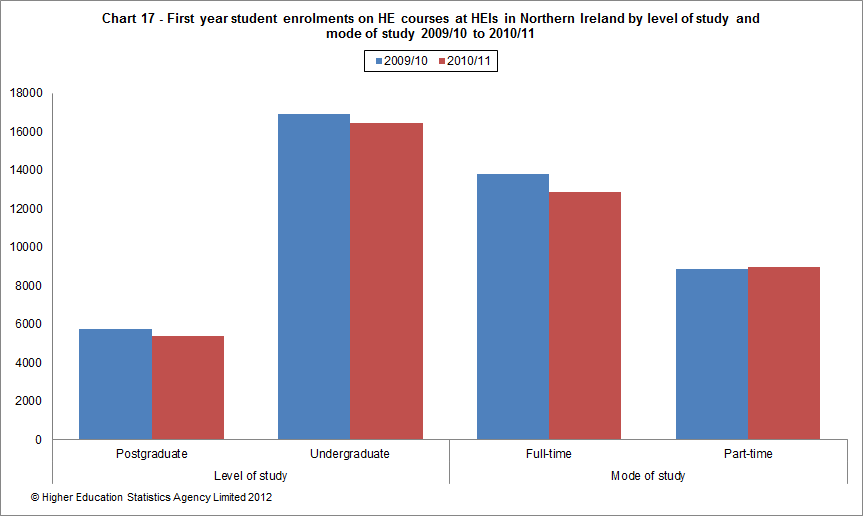
In 2010/11, 73% of Northern Ireland domiciled first year undergraduates studied at Northern Ireland HEIs (excluding The Open University) compared to 76% in 2009/10. Similarly, 72% of Northern Ireland domiciled first year postgraduates studied at Northern Ireland HEIs (excluding The Open University), compared to 71% in 2009/10. (Ref. Table 4 and Chart 6)
Key points - qualifications obtained (Northern Ireland only)
In 2010/11 there were 8,115 first degree graduates compared to 8,235 in 2009/10, a decrease of 1%. (Ref. Table 5a)
First degrees accounted for 54% of qualifications obtained in 2010/11. (Ref. Table 5a and Chart 18)
Chart 18 illustrates the distribution of qualifications obtained at Northern Ireland HEIs in 2010/11.
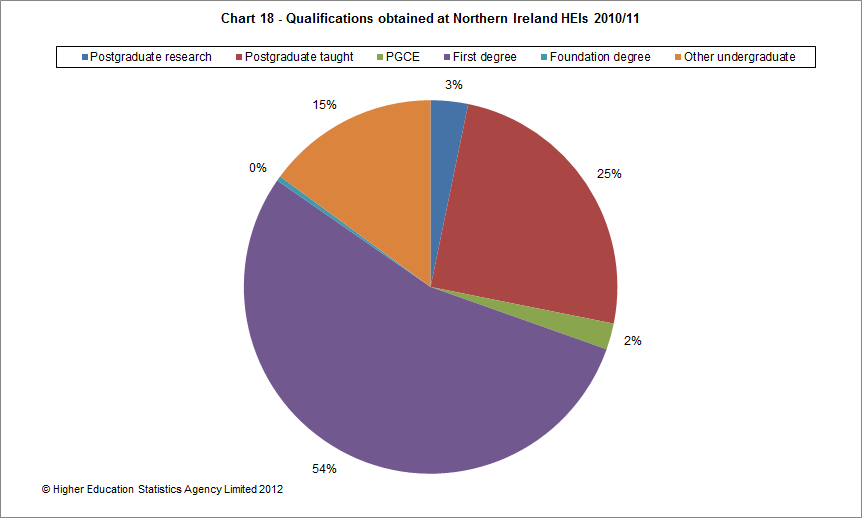
61% of first degree graduates in 2010/11 were women, the same proportion as in 2009/10. (Ref. Table 5a)
4,550 HE qualifications obtained in 2010/11 were at Postgraduate level, an increase of 12% from 2009/10. (Ref. Table 5a)
Tables
| All student enrolments on HE courses by level of study, mode of study and domicile 2006/07 to 2010/11 | |
| All student enrolments on HE courses by location of HE institution, mode of study, domicile and level of study 2006/07 to 2010/11. | |
| First year student enrolments on HE courses by level of study, mode of study and domicile 2006/07 to 2010/11. | |
| First year student enrolments on HE courses by location of HE institution, mode of study, domicile and level of study 2006/07 to 2010/11. | |
| Student enrolments on HE courses by level of study, subject area and mode of study 2006/07 to 2010/11. | |
| Student enrolments on HE courses by level of study, subject area, mode of study and location of HE institution 2010/11. | |
| UK domiciled, first year student enrolments on HE courses by level of study, mode of study, domicile and location of HE institution 2009/10 and 2010/11. | |
| Qualifications obtained by students on HE courses at HEIs in the UK by gender, level of qualification obtained, mode of study and domicile 2006/07 to 2010/11. | |
| Qualifications obtained by students on HE courses at HEIs in the UK by location of HE institution, gender, level of qualification obtained, mode of study and domicile 2006/07 to 2010/11. | |
| Class of degree achieved by students obtaining first degree qualifications at HEIs in the UK by gender and mode of study 2006/07 to 2010/11. | |
| Class of degree achieved by students obtaining first degree qualifications at HEIs in the UK by location of HE institution, gender and mode of study 2010/11. | |
| Qualifications obtained by students on HE courses at HEIs in the UK by gender, subject area and level of qualification obtained 2006/07 to 2010/11. | |
| Qualifications obtained by students on HE courses at HEIs in the UK by gender, subject area, location of HE institution and level of qualification obtained 2010/11. | |
| Students studying wholly overseas by location of HE institution, location, type of provision and level of provision 2008/09 to 2010/11. |
None of the tables presented should be interpreted without reference to the Notes to editors and Definitions provided below.
Notes to Editors
The United Kingdom Statistics Authority has designated these statistics as National Statistics, in accordance with the Statistics and Registration Service Act 2007 and signifying compliance with the Code of Practice for Official Statistics.
Designation can be broadly interpreted to mean that the statistics:
- Meet identified user needs
- Are well explained and readily accessible
- Are produced according to sound methods
- Are managed impartially and objectively in the public interest.
Once statistics have been designated as National Statistics it is a statutory requirement that the Code of Practice shall continue to be observed.
-
The data presented in this SFR is based on the 2010/11 HESA Student and Aggregate offshore records. The statistics in this SFR are derived by HESA from data collected from all publicly funded HEIs in the UK (including The Open University - see definition 5) and The University of Buckingham, which is privately funded. The figures therefore exclude HE enrolments and qualifications obtained by students registered at UK further education colleges and at other private and independent UK HE colleges.
The 2010/11 data for HE enrolments in further education colleges in the UK is not included in this SFR, however this data will be published in Table 1 of the HESA publication, Higher Education Statistics for the United Kingdom, in September 2012.
- There were considerable changes in the enrolments and qualifiers data collection from 2007/08 onwards. As a result some time series data relating to 2006/07 within this release will not correspond to previously published HESA data.
- The specification of the HESA standard registration population has changed for enrolments from 2007/08 onwards. Writing-up and sabbatical students are now excluded from this population where they were previously included in published enrolment data. In order to maintain time series accuracy, all data for 2006/07 has been run using the 2007/08 definition of the standard registration population (excluding writing-up and sabbatical students). As a result, enrolment data will not match other previously published HESA data for the years 2006/07.
- From 2007/08 the specification for student gender falls within the scope of the Aligned Data Definitions adopted by the Information Standards Board for education, skills, and children's services. Students of ‘indeterminate gender' are included in total figures but not in separate breakdowns.
- Students with a domicile of ‘UK unknown' have been included in total figures but not in separate breakdowns.
- First degree qualifiers with a classification of ‘not applicable' have been included in total figures but not in separate breakdowns. These qualifiers are also not included in percentage calculations.
-
In 2006/07, an institution in Scotland misreported a number of awards (1,295) as ordinary degrees, showing in the tables as unclassified awards. This should be taken into account when looking at time series in Table 6.
In 2006/07, an institution in Northern Ireland reported a number of unknown domiciles (955), mostly on short credit bearing courses within their Open Learning Programme. Consequently the number of Northern Ireland students in Northern Ireland institutions may be under-reported by this amount.
In the years 2006/07, an institution in Scotland misreported a number of part-time qualifiers as postgraduate taught when they should have been classified as undergraduate. As a result, postgraduate taught figures in Table 5a may be over-reported for 2006/07.
In 2008/09, an institution in England misreported 305 other undergraduate incoming exchange students as non-exchange students. As a result these students appear in the enrolment figures where they would have usually been excluded.
In 2008/09, an institution in Wales showed a drop of 2,195 part-time enrolments. This was due to those students being recorded as dormant which automatically excluded them from enrolment data. This should be taken into account when looking at part-time time series.
Prior to 2008/09, an institution in Scotland missed a number of awards from their qualifications obtained data submission. From 2008/09, these awards have now been included in the submission and have resulted in an increase in number of qualifications obtained. This should be taken into account when looking at time series for qualifications obtained.
In 2009/10, an institution in Wales changed its reporting practices for a number of their full-time postgraduate taught students that were active over two reporting years. These students were previously returned as active in their first year but dormant in their second year. For 2009/10 these students were returned as active in both academic years, in line with HESA reporting requirements. Consequently the number of full-time postgraduate enrolments in Wales has shown a larger percentage increase than expected.
- In 2008/09, an institution in Northern Ireland misreported a number of part-time students (280) as non-EU domicile. Consequently this had a considerable effect on the number and percentage change from 2007/08 to 2008/09 of non-EU and UK domiciled students in Northern Ireland institutions. As a result, part-time and total data by domicile for Northern Ireland HEIs has been suppressed from Table 1a and 2a. This may also result in some under-reporting of domicile figures in Table 4 although the effect is not judged to be of sufficient magnitude to warrant suppression.
- In 2008/09, an institution in Northern Ireland miscoded a number of part-time, other undergraduate post-registration nursing and midwifery qualifiers (525). Consequently the number of part-time other undergraduate qualifiers at institutions in Northern Ireland was under-reported by this amount. As a result, affected data in Table 5a has been suppressed.
- Foundation degrees have not been introduced in Scotland. As numbers of foundation degree students in Wales and Northern Ireland are small, these are not separately reported in the text of this SFR.
- A statistical reference volume ‘Students in Higher Education Institutions 2010/11' based on the HESA Student record and setting out more information about students in higher education in the UK will be published by HESA in February 2012.
- For the purposes of Table 4, ‘England HEIs' does not include data for The Open University. Data for this institution is shown separately and included in total figures. For all other tables, The Open University is included within ‘England HEIs'.
- In 2008/09, an institution in Scotland misreported a number of students as ‘Students registered at a UK HEI' instead of ‘Students studying for an award of a UK HEI'. This should be taken into account when comparing these Aggregate offshore figures in Table 8.
- Students registered at Oxford Brookes University accounted for 47.6% of the total population of the 2010/11 Aggregate Offshore record (39.7% in 2009/10). The majority of these students were registered with an overseas partner on Association of Chartered Certified Accountants (ACCA) programmes.
Definitions
-
Higher education
Higher education (HE) students for the purpose of HESA's data collection are those students on courses for which the level of instruction is above that of level 3 of the Qualifications and Curriculum Authority (QCA) National Qualifications Framework (NQF) (e.g. courses at the level of Certificate of HE and above).
The reporting period for the 2010/11 student record is 1 August 2010 to 31 July 2011.
-
Level of study/qualification obtained
Postgraduate courses are those leading to higher degrees, diplomas and certificates (including Postgraduate Certificate of Education (PGCE) and professional qualifications) and usually require that entrants are already qualified to degree level (i.e. already qualified at level 6 of the QCA National Qualifications Framework). In analyses where postgraduate level of study is disaggregated into postgraduate (research) and postgraduate (taught), the following groupings are used:
Postgraduate (research) includes doctorate (incorporating New Route PhD), masters degrees and postgraduate diplomas or certificates (not Postgraduate Certificate in Education (PGCE) at level M) studied primarily through research.
Postgraduate (taught) includes doctorate, and masters degrees, postgraduate bachelors degrees at level M and postgraduate diplomas or certificates not studied primarily through research, including Postgraduate Certificate in Education (PGCE) at level M (unless shown separately), Masters in Teaching and Learning, level M Diploma in Teaching in the Lifelong Learning Sector, and professional qualifications.
First degree includes first degrees with or without eligibility to register to practice with a health or social care or veterinary statutory regulatory body, first degrees with Qualified Teacher Status (QTS)/registration with a General Teaching Council (GTC), enhanced first degrees (including those leading towards obtaining eligibility to register to practice with a health or social care or veterinary statutory regulatory body), first degrees obtained concurrently with a diploma and intercalated first degrees.
Foundation degrees were first introduced in September 2001. They are vocational higher education qualifications at level 5 of the QCA National Qualifications Framework.
Other undergraduate includes qualification aims equivalent to and below first degree level, such as Professional Graduate Certificate in Education (PGCE), foundation degrees, diplomas in HE with eligibility to register to practice with a health or social care or veterinary statutory regulatory body, Higher National Diploma (HND), Higher National Certificate (HNC), Diploma of Higher Education (DipHE), Certificate of Higher Education (CertHE), foundation courses at HE level, NVQ/SVQ levels 4 and 5, post-degree diplomas and certificates at undergraduate level (including those in Teaching in the Lifelong Learning Sector), professional qualifications at undergraduate level, other undergraduate diplomas and certificates including post registration health and social care courses, other formal HE qualifications of less than degree standard, institutional undergraduate credit and non-formal undergraduate qualifications.
Further education programmes of study (applicable to table 8 only) include diplomas, certificates and National Vocational Qualification (NVQ)/Scottish Vocational Qualification (SVQ) at level 3 and below, A/AS levels, Advanced Highers/Highers (Scotland), GCSEs, Intermediates (Scotland), HE Access courses, Welsh for Adults and other qualifications below higher education level.
-
Mode of study - enrolments
Full-time includes students recorded as studying full-time, normally required to attend an institution for periods amounting to at least 24 weeks within the year of study, plus those enrolled on a sandwich course (thick or thin), irrespective of whether or not they are in attendance at the institution or engaged in industrial training, and those on a study-related year out of their institution. During that time students are normally expected to undertake periods of study, tuition or work experience which amount to an average of at least 21 hours per week for a minimum of 24 weeks study/placement.
Part-time students are those recorded as studying part-time, or studying full-time on courses lasting less than 24 weeks, on block release, or studying during the evenings only.
Mode of study - qualification obtained
Full-time students are those whose study was recorded as full-time (as described above), and also includes awards from dormant and writing-up status where the student's mode of study was previously full-time.
Part-time students are those whose study was recorded as part-time (as described above), and also includes awards from dormant and writing-up status where the student's mode of study was previously part-time, and awards given to those on sabbatical.
-
Domicile
UK domiciled students are those whose normal residence is in the UK, and for the purposes of this publication include Guernsey, Jersey and the Isle of Man. (Officially, the Crown Dependencies of Guernsey, Jersey and the Isle of Man are not part of the UK or the EU).
Other European Union domiciled students are those whose normal residence prior to commencing their programme of study was in countries which were European Union (EU) members (excluding the UK) at 1 December of the reporting period. This includes Austria, Belgium, Bulgaria, Cyprus, Czech Republic, Denmark, Estonia, Finland, France, Germany, Gibraltar, Greece, Hungary, Ireland, Italy, Latvia, Lithuania, Luxembourg, Malta, Netherlands, Poland, Portugal, Romania, Slovakia, Slovenia, Spain and Sweden.
Non-European-Union students are those whose normal residence prior to commencing their programme of study was outside the EU. Where Non-EU countries are shown separately, individual country figures exclude the country's overseas territories. These individual country figures are listed within the geographic region in which they lie.
On 1 January 2007 two additional countries joined and these are listed below. Up to 2006/07 the 2007 accession countries are included in the ‘Non-EU' category in the tables; as from 2007/08 these countries are included in the ‘Other EU' category.
The table below illustrates the position regarding student enrolments in HE using HESA standard definitions. The brackets indicate the figures for the 2007 accession countries prior to their inclusion on 1 January 2007.
2006/07 2007/08 2008/09 2009/10 2010/11 EU countries excluding UK 105,410 112,150 117,660 125,045 130,120 of which EU countries prior to 1 January 2007 105,410 109,720 113,310 118,455 120,880 EU 2007 accession countries (1,295) 2,430 4,345 6,590 9,240 2007 accession countries: Romania and Bulgaria
-
Location of institution
The allocation of an institution to a geographical region is done by reference to the administrative centre of that institution. There may be students registered at institutions who are studying in regions other than that of the administrative centre of the institution.
The Open University is counted as a wholly English institution. The administrative centre is located in England, although The Open University teaches throughout the UK.
-
Class of first degree
The classification of a first degree indicates the qualification class obtained. Certain qualifications obtained at first degree level are not subject to classification of award, notably medical and general degrees. These, together with ordinary degrees and aegrotat qualifications have been included within Unclassified. Third class honours, fourth class honours and the pass have been aggregated as Third/pass. Lower second and undivided second class honours have been aggregated as Lower second. The percentage calculations included in this SFR are expressed excluding unclassified first degrees from the denominator.
-
First year
First year students are based on the HESA standard registration population who commenced their instance in the relevant reporting period. The term 'instance' is used to describe a student's engagement with the institution aiming towards the award of a qualification(s) or credit.
-
Age
Age is as at 31 August within the relevant academic year.
-
Students studying wholly overseas
These are students studying wholly outside the UK who are either registered with a reporting UK higher education institution or who are studying for an award of the reporting institution.
-
Location of provision
Within the European Union includes students whose location of study country was a European Union (EU) member state.
Guernsey, Jersey and the Isle of Man, for the purposes of this SFR, are counted as within the European Union.
-
Type of activity
Type of activity defines the arrangements under which overseas programmes are provided.
Students registered at a UK higher education institution includes:
Overseas campus of reporting institution includes those studying at a campus set up as a branch campus of the parent institution, and as such it is seen as no different from any other campus of the institution.
Distance, flexible or distributed learning denotes educational provision leading to an award of an awarding institution delivered and/or supported and/or assessed through means which generally do not require the student to attend particular classes or events at particular times and particular locations. There are a small number of distance learning students studying outside the UK who are funded (e.g. Crown servants overseas and the Services). These students are returned in the Student record and not included in the Aggregate offshore record.
Other arrangement including collaborative provision denotes provision leading to an award of an awarding institution delivered and/or supported and/or assessed through an arrangement with a partner organisation. Collaborative provision, sometimes described as 'franchised' provision includes consortia and joint award arrangements.
Students studying for an award of a UK higher education institution includes:
Students studying for an award of a UK HEI are not registered students of the reporting institution but are studying for an award of the reporting institution, and are registered at an Overseas partner organisation or via some Other arrangement.
-
Rounding Strategy
In the text and tables the figures presented are rounded. 0, 1 and 2 are rounded to 0. All other numbers are rounded up or down, to the nearest 5. Percentages are calculated on the base data and are suppressed if they are calculated on a population which contains 52 or fewer individuals. These cases are represented as '..'.
- Press enquiries should be directed to the Press office at the Higher Education Statistics Agency (HESA), 95 Promenade, Cheltenham, GL50 1HZ: Tel: 01242 211120. General enquiries about the data contained within this SFR should be addressed to James McLaren, Information Provision Manager, HESA (at the same address), telephone: 01242 211133.
Ends
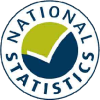
Embargo
12 January 2012, 9:30
Coverage
UK
Themes
Children, education and skills
Issued by
HESA, 95 Promenade, Cheltenham, GL50 1HZ
Press enquiries
01242 211120
Public enquiries
01242 211133
Statistician
James McLaren




